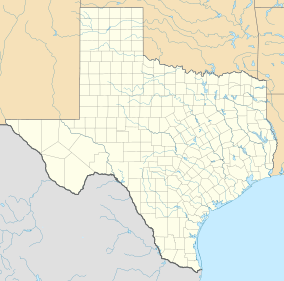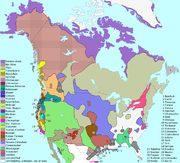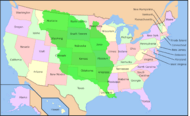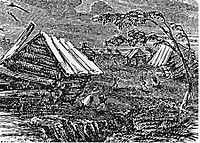Caddo Lake State Park facts for kids
Quick facts for kids Caddo Lake State Park |
|
|---|---|
|
IUCN Category IV (Habitat/Species Management Area)
|
|
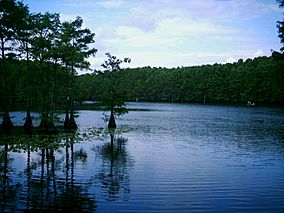
Caddo Lake viewed from a point near Uncertain
|
|
| Location | Harrison County, East Texas, Texas, United States |
| Area | 468 acres (189 ha) |
| Elevation | 237 ft (72 m) |
| Established | June 1933 |
| Named for | the Caddo tribe who inhabited the area |
| Governing body | Texas Parks and Wildlife Department |
| Website | Caddo Lake State Park |
Caddo Lake State Park is a special place in East Texas. It's a state park that protects part of Caddo Lake. This lake is one of the few natural lakes in Texas. The park covers about 468 acres (190 ha) of land. It is located in Harrison County, near a town called Karnack, Texas.
Caddo Lake is famous for its many bald cypress trees. These trees grow right out of the water! The park is also a great place to see wildlife. It's managed to help protect animals and plants.
Contents
Discovering Caddo Lake's Past
Early People and Explorers
People first lived near Caddo Lake about 12,000 years ago. They used the lake's marshy areas to find food. Around 800 AD, the first Caddo settlements appeared. The Caddo were peaceful groups who lived close together. They became skilled farmers by 1200 AD, growing crops like corn.
In 1542, a Spanish expedition led by Luis de Moscoso Alvarado found the Caddo people. They sent back the first descriptions of this complex society. More European explorers came to the area in the 1600s. In the 1700s, the Spanish set up trading posts. Sadly, European diseases caused many Caddo people to die. The Caddo used the nearby Red River for trading.
The 1800s: Big Changes
The Louisiana Purchase and Borders
In 1800, France got the land called Louisiana back from Spain. This was a secret deal. In 1803, the United States bought Louisiana from France. This deal was called the Louisiana Purchase. It made the United States twice as big!
But the borders of Louisiana were not clear. This caused problems between Spain and the United States. They both claimed the Caddo Lake area. In 1806, they agreed to create a "Neutral Territory." This area had no official owner. Because of this, no one could enforce laws there. It became a place where outlaws and escaped slaves hid. Soldiers were sent twice to clear out the outlaws.
How Caddo Lake Was Formed
No one knows exactly when Caddo Lake was formed. But there are two main ideas, both from the early 1800s.
- The Earthquake Idea: The Caddo people have a legend. They say a powerful spirit caused an earthquake because a chief didn't obey him. This earthquake filled the land and made the lake. Some scientists think this story describes the 1811–12 New Madrid earthquakes. They believe these earthquakes made the ground sink, creating the lake.
- The Great Raft Idea: Another idea is that the lake formed because of the Great Raft. This was a huge jam of logs and trees that blocked the Red River. It acted like a natural dam. This dam caused water to back up, forming Caddo Lake. Explorers first saw parts of this log jam in the 1500s. Scientists studied it in the early 1800s.
New Borders and Texas Independence
In 1819, the Adams–Onís Treaty was signed. This treaty set the border between Spanish Texas and Louisiana. It put the Caddo Lake area inside Texas. In 1821, Mexico won its independence from Spain. This included the land where Caddo Lake State Park is today. Later, the Republic of Texas won its own independence from Mexico. Texas then joined the United States.
The 1900s: Building the Park
Creating Caddo Lake State Park
In 1931, the Texas government decided to make Caddo Lake a public park. Land was given by different groups and people between 1933 and 1937. A large part of the land came from Thomas Jefferson Taylor II.
The Civilian Conservation Corps (CCC) started building the park in 1933. The CCC was a program during the Great Depression. It gave jobs to young men. They built many things at the park, including:
- Park entrances
- Roads and trails
- A shelter house
- A boat house
- Nine cabins for visitors
- A building for groups (now the recreation hall)
- Picnic spots
- Bridges
Another CCC group finished the work in 1937.
Nature at Caddo Lake State Park
Caddo Lake State Park is a huge area of cypress swamp. It's like a giant maze of small rivers and channels. The lake itself is usually about 8 to 10 feet (2.4 to 3.0 m) deep. But some parts of the channels can be about 20 feet (6.1 m) deep.
This park is a paradise for people who love fishing and nature.
- Fish: The lake has 71 different kinds of fish! It's especially good for catching crappie, largemouth bass, and white bass.
- Plants: You can see tall cypress trees, beautiful American lotus flowers, and water lilies.
- Animals: Many animals live here, including:
- Waterfowl (ducks, geese)
- Alligators
- Turtles
- Frogs
- Snakes
- Raccoons
- Mink
- Coypu (also called nutria)
- Beavers
- Squirrels
- Armadillos
- White-tailed deer
Nearby Parks to Explore
If you're visiting Caddo Lake State Park, here's another state park close by:
- Starr Family Home State Historic Site (also in Harrison County)
Images for kids
-
Channel in Caddo Lake
-
Caddo Lake during winter.


